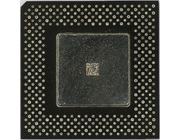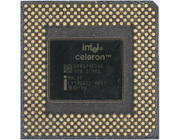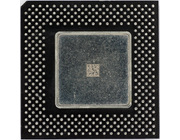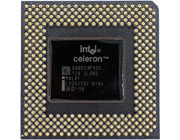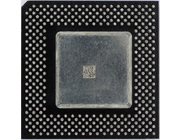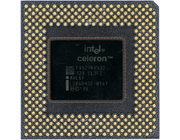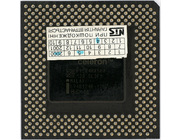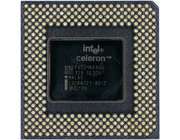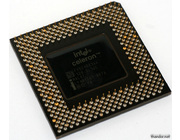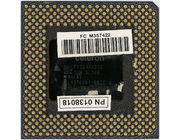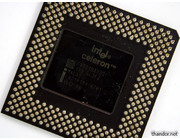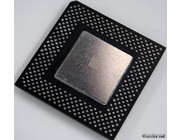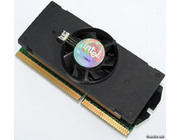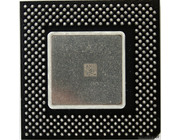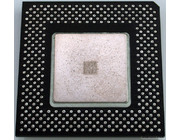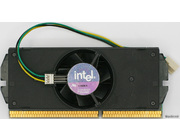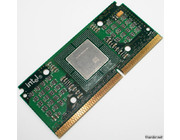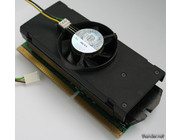Intel's Mendocino, or second version of the Celeron, performaned better than the original Covington. Although it was basically the same processor, the new version did have 128KB L2-cache. Now the L2-cache even ran at full-speed which boosted performance. To avoid confusion Intel used the 'A' suffix for the 300MHz and 333MHz models.
Overclockers loved the new Celeron. Many 300MHz or 333MHz models could run at 373MHz or 416MHz which is quite a noticeable difference.
Identical to this Celeron 533 but with different sSpec: the SL3PZ came in an Intel box with heatsink/fan included. > Read more
I have three Celeron 366's:
1. This one with sSpec SL35S that was a Boxed CPU without heatsink.
2. The SL36C which is identical but for OEM's (came in trays).
3. A Slot 1 variant. It also has an A-stepping core.
Basically they all work identical. The Slot 1 CPU I have is a bit older and uses the A0-stepping core instead of B0-stepping.
Performance-wise the Celeron 366 is about identical to the Pentium II 350. The Celeron was usually favorable due it's price point and, for enthusiasts, it's overclock ability. > Read more
Although I do like the Celeron 'Mendocino' as cool running and overclockable CPU (especially with the lower clocked CPU's) this particular 466MHz part was not spectacular in the 12th week of 2000 since you could already get a 1000MHz Athlon at that time. Of course at extra cost ![]() .
.
The 466 was officially released in April 1999. > Read more
Identical to this Celeron 433 in terms of functionality and stepping (both B0). The only difference is that the sSpec code: this one has SL3BS which once was shipped in an Intel box with Intel heatsink/fan. The SL3BA sSpec was delivered in trays for OEM's. > Read more
Identical to this Celeron 400 but with a different sSpec. The sSpec indicates that this CPU once came in an Intel box (with heatsink/fan).
In it's day the Celeron 400 was a nice performer. In most cases faster than the competing AMD K6/2-400. The Celeron 400 and the Pentium II 400 perform almost identical depending on the application. They both run at 400MHz but the Celeron favors on-die full-speed L2-cache. However, the Pentium II has a bigger (yet slower) L2-cache and favors a faster front-side-bus (100MHz opposed to 66MHz). > Read more
I have another Celeron 533 with the same sSpec number. The one I had didn't work so I decided to go for another CPU. Besides being identical this 533 is made in the 6th week of 2002 which makes it a pretty late model for a Mendocino-core based Celeron. Back in 1998/1999 these were interesting CPU's and in 2000 you'd generally see the last budget iteration. Perhaps Intel continued to make these CPU's for a market that wanted CPU's for their non-FCPGA S370-platform.
533MHz is the fastest Celeron avaiable for the first generation S370 platform. The Coppermine-based CPU's needed a FC-PGA compatible motherboard. > Read more
Identical to this Celeron 500 but with a different sSpec. This particular CPU came in trays rather than an original Intel box. > Read more
Identical to this Celeron 466 but with different sSpec number. The SL3EH was a CPU that came on trays rather than an Intel box that included a heatsink/fan. > Read more
Identical to this Celeron 366 except that this CPU was shipped in a tray rather than an official Intel box. > Read more
The Celeron 333 sold in both slot 1 and socket 370 variants. Back in the day of the Pentium II, slot 1 was used for Intels' latest processors. using slot 1 Intel could move the L2-cache right next to the processor rather than on the motherboard. This is called off-die L2-cache and was faster than L2-cache on the motherboard.
Later Intel combined the L2-cache with the processor itself. Rather than sticking it next to the processor; it was integrated in the processor 'die'. This is called on-die L2-cache and is noticeably faster than off-die L2-cache. However, don't me mistunderstood; the Celeron 333 on slot 1 and socket 370 both have on-die L2-cache. Intel just placed the socket 370 Celeron on a slot 1 package so that it would be backwards compatible with older slot 1 motherboards. > Read more
The fastest black PPGA Celeron available but unfortunatly still with a slow 66MHz front side bus (FSB). When the 333MHz Celeron was new, the 66MHz FSB was adequate. I guess the Celeron in the range of 500 - 550MHz could benefit nicely from a 100MHz front-side-bus but that's how thing go with a budget class CPU ![]() . Intel can't risk having their budget-line competing with the high-end line. > Read more
. Intel can't risk having their budget-line competing with the high-end line. > Read more
Just running at 500MHz; nothing less, nothing more. It is the second fastest Celeron 'Mendocino'. It was surpassed by the 533MHz version and with the 566MHz models Intel used the newer Coppermine core.
This particular CPU (with sSpec SL3LQ) once came in an Intel boxed with heatsink/fan included. > Read more
The Celeron like it should be. The 300MHz Celeron was also available with the 'Covington' core that is slower because it lacks L2-cache. This particular Celeron 300A is based on the 'Mendocino'-core that has 128KB full-speed L2-cache integrated. You can identify the differences by the A-designation or by looking up the sSpec number.
Both Celeron 300's (with and without L2-cache) are quite good overclockers. Most of them can run at 373MHz by setting the FSB to run at 83MHz. > Read more
Just as the Celeron 400 but 33MHz faster. Just as with the Celeron 333/366 and 400, the 433 was an interesting CPU in price/performance. Even when overclocking you could often increase the FSB to 75 or 83MHz without too much hassle. This would result in respectively 487MHz and 540MHz.
If you wanted performance without overclocking you could get, for instance, a Pentium III 700 or Athlon 800 in early 2000. > Read more
Technically this Celeron 400 is just like the 366MHz slot 1 variant but then in socket form.
The Celeron 400 was a good performer and could still run in the older slot 1 boards using a slotket adapter. > Read more
Similar to this Celeron 333 but 33MHz faster. Performance-wise the Celeron 366 runs in the neighborhood of the Pentium II 350.
As with all the lower clocked Mendocino Celerons (300, 333, 366) they all overclock pretty good. 412MHz/75FSB and 456MHz/83FSB are usually within reach. If you had a chipset that can run 100MHz FSB chances are this CPU will also run, perhaps with slight increase in voltage, at 550MHz.
The 366MHz model was also available for socket 370 systems. See this Celeron 366 for pictures of the socket 370 variant. > Read more
Same as this Celeron 333 but someone once removed the heatsink/fan (Shroud) solution.
My experiences with the Intel heatsink/fan are quite good. They seem to be reliable and do it's job just fine. Perhaps someone removed the stock heatsink/fan to upgrade the cooling solution with the benefit of higher clock frequencies: the Celeron 333 was quite a good choice for overclocking. Increasing the FSB to 75MHz would result in 375MHz or running it at 83MHz would boost up to 415MHz. A lot of these CPU's could run at those frequencies without problems. > Read more
The Celeron as it should be. The first Celeron ever released didn't have L2 cache at all making it cheap to produce but quite slow. Intel changed this by adding 128KB full-speed on-die L2 cache into it's playground. This time the cache ran at 100% of the core clockfrequency (333MHz in this case) and was integrated into the processor rather then installed besides the processor like the Pentium II had.
Because the L2 cache is integrated the transistor count increases greatly. The 'Covington' without L2 cache only has 7,5 million transistors where this 'Mendocino' goes up to 19 million transistors!
This particular CPU is equipped with Intels' shroud-cooling solution. They provide adequate cooling and seem to be very reliable over the years. I haven't seen many of these fans fail or rattle over the years. > Read more
